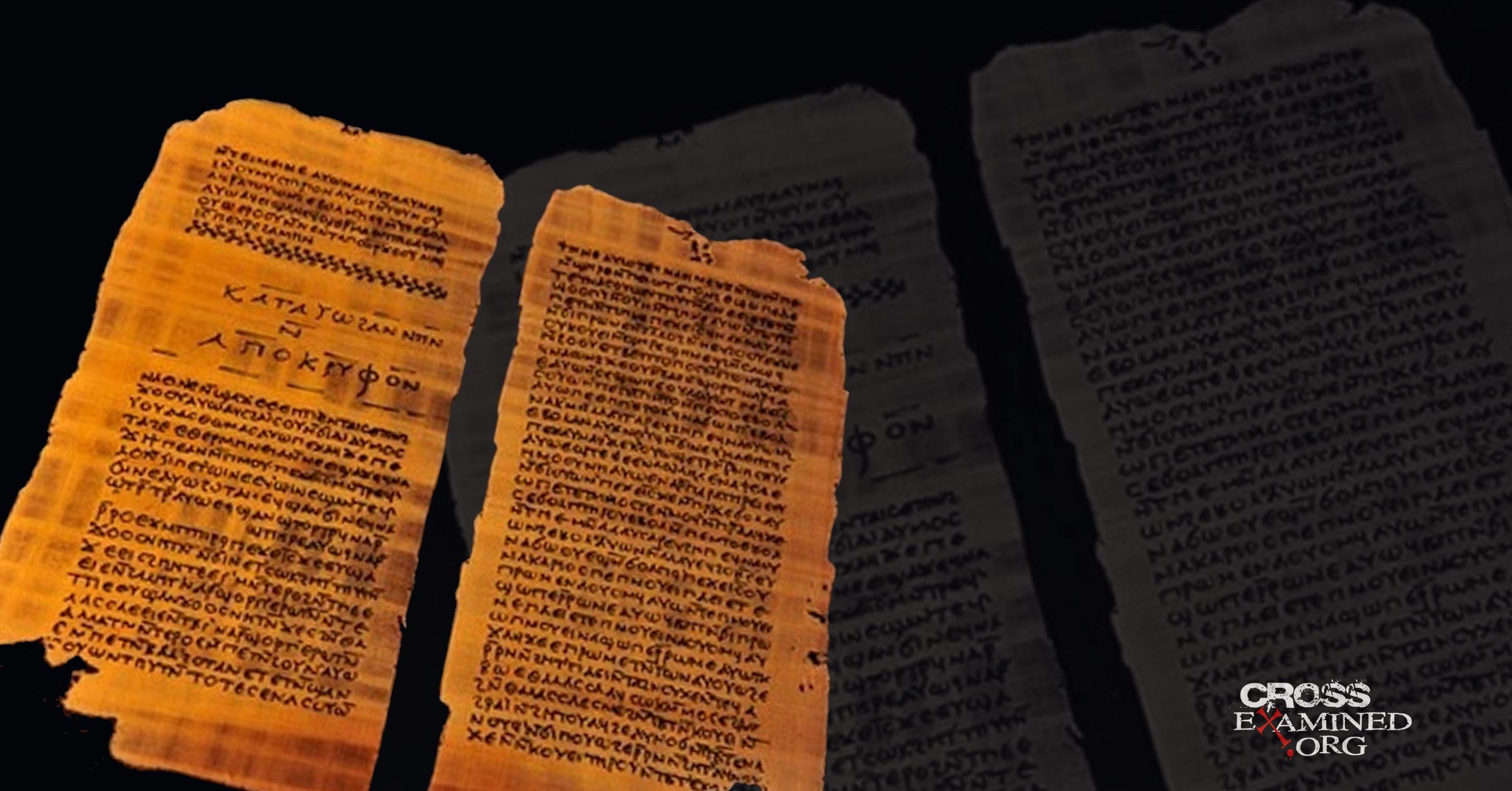There’s a common refrain among liberal scholars that says the church suppressed dozens of Gospels. The reason they say? It’s because those books share scandalous information about Jesus that the church wanted to hide. They didn’t want the world to know sketchy details like Jesus tortured other kids as a child or that he had a wife.
Of all these “suppressed” Gospels, far and away the poster child is the Gospel of Thomas. Liberal scholars such as John Dominic Crossan and Elaine Pagels faun over this work. The Jesus Seminar even published a book titled The Five Gospels, which includes the canonical four-plus Thomas.
Yet there’s a bit of irony here. If these scholars would treat the canonical Gospels with half the amount of charity they give to Thomas, they’d all be Christians! Instead, they date Thomas very early and the canonical Gospels late. They claim Thomas’ view of Jesus is reliable, while the canonical Gospels contain myths and legends.
By contrast, I’m going to demonstrate, in the remaining pace, that the Gospel of Thomas is unreliable, was never considered as Scripture by the early church, and thus shouldn’t be included in our canon.
The Gospel of Thomas
In 1945, some farmers in Nag Hammadi Egypt were digging and came across an earthenware jar in the ground. The farmers, hoping to find treasure, were deeply disappointed when they found a bunch of texts instead. Little did they know those texts would be more valuable than any treasure they could hope to find.
Among the cache of texts was one that begins, “These are the secret sayings which the living Jesus spoke and which Didymos Judas Thomas wrote down,” and ends with “The Gospel According to Thomas.”
Unlike the canonical Gospels, Thomas doesn’t follow a narrative structure. It doesn’t report major parts of Jesus’ life — his birth, death, and resurrection. Instead, Thomas contains 114 esoteric sayings of Jesus, purporting to record the secrets Jesus taught to his disciples.
Canonical Attributes
Before we can answer why Thomas doesn’t belong in the canon, we need to know what the early church looked for in a canonical book. In sum, the church looked for three different attributes — apostolic authority, divine qualities, and corporate reception.1 These three attributes formed a type of canonical grid by which to test a book.
By apostolic authority, the church only received books that could be traced to apostolic eye-witness testimony. This would include books written by both apostles and their close associates. For example, the church obviously received John’s writings because he was one of the apostles. But they also received Mark, based on the fact that he was Peter’s close associate.
By divine qualities, the church looked for books that gave evidence of God’s fingerprints. One such piece of evidence was consistency with other authoritative books. Since Christians believe the Holy Spirit inspired all the biblical texts, they knew none of them would contradict each other.
By corporate reception, the church only received books that the universal church also received as authoritative. In other words, if only one pocket of Christianity affirmed the authority of a book, that book was rejected. The reception had to stretch across all of Christendom.
So does the Gospel of Thomas possess these canonical attributes? Let’s test it by putting it through the canonical grid.
Apostolic Authority?
Did an apostle or close associate write the Gospel of Thomas? In a word, no. In fact, the consensus among scholarship is that the book dates to the middle of the second century — long after the apostles had died out. That is to say, Jesus’ disciple Thomas did not write this book.
A few reasons exist for dating this work late into the second century. First, the text reflects a type of Gnosticism (more on that in a minute) that wasn’t prevalent until the middle second century.2
Additionally, the Gospel of Thomas demonstrates a deep dependance on large parts of the New Testament. It quotes or alludes to all four Gospels, Acts, most of Paul’s letters, and Revelation.3 Only someone who had access to all these works could pen this work, and we know that it took time for these works to circulate the Roman Empire.
Even more, some scholars suggest that Thomas relied heavily on the Diatessaron — a four Gospel harmony produced by Tatian around AD 170.4 If that’s the case, Thomas dates even later.
Even if Thomas is independent of the Diatessaron, it’s mid-second century dating would have ruled it out for canonical consideration. Take the Shepherd of Hermas — a mid-second century work — for example. The early church loved this book. But as the Muratorian Fragment states, the church rejected its canonical authority because it was written “quite recently, in our own times,” and thus not backed by apostolic authority.5
Strike one for Thomas.
Divine Qualities?
What about divine qualities? Does Thomas show God’s fingerprints and align with other authoritative books? Again, the answer is no. Thomas was one of several Gnostic texts in the Nag Hammadi discovery.
Gnosticism was polytheistic. It taught that the god who created the world was evil, and by extension, his entire creation was evil too. Salvation, then, was the liberation of the soul from the physical realm into a spiritual realm. One can achieve this salvation only through a secret knowledge (gnosis in Greek).
This secret knowledge, according to the Gnostics, comes from Jesus. Of course, Jesus was radically different from the god of the Old Testament. Jesus was a warm and inviting god while the one of the Old Testament was hostile and angry.
Furthermore, since everything physical is evil, Jesus didn’t really have a physical body. He only appeared to have a human body, and thus he didn’t die on the cross — a view known as Docetism.
The Gospel of Thomas makes no qualms about its Gnostic leanings with all its emphasis on learning the secrets of Jesus. The prologue begins, “These are the secret sayings that the living Jesus spoke.” Moreover, the first saying states, “Whoever discovers the interpretation of these sayings will not taste death.” Again, the Gnostic salvation came through obtaining a secret knowledge.
Of course, the early church rejected Gnosticism as heretical. Orthodoxy taught salvation by faith. Thomas taught salvation came through knowledge of secret information.
Thomas also veers away from orthodoxy in how it views women. At the close of the book, Jesus states, “Look, I will guide her (Mary) to make her male, so that she too may become a living spirit resembling you males. For every female who makes herself male will enter the kingdom of Heaven.”
This statement clearly contradicts how Jesus views women in the canonical Gospels. Furthermore, it contradicts Genesis 1, which declares that God made both men and women in his image. Thus, women are not inferior, as the Gospel of Thomas suggests.
Strike two for Thomas.
Corporate Reception?
Did the universal church affirm the authority of Thomas? There’s not a shred of evidence to suggest that it did. If you think about it, since Thomas lacks the first two attributes — apostolic authority and divine qualities — the early church had no motivation to think it was Scripture.
Their rejection of this book is evidenced in two ways. First, the early church never includes Thomas in any of its early canonical lists. In all the lists, we have four, and only four, Gospels.
Second, the church specifically rejected Thomas as heretical. Meaning, it didn’t even come close. This rejection is contrasted with other books, like the Shepherd of Hermas or the Didache, that at least gained a hearing. The church enjoyed these books as they promoted Christian orthodoxy, but as I alluded to earlier, the church didn’t receive them as Scripture because they lacked apostolic authority.
Thomas was so far out in left field that it wasn’t even up for discussion. Eusebius, for example, includes Thomas in the “heretical books” section and suggests that it “ought not to be reckoned even among the spurious books but discarded as impious and absurd.”6
Strike three for Thomas.
The Gospel of Thomas Rejected
Despite the best efforts of some, Thomas doesn’t even come close to Scripture. It wasn’t backed by apostolic authority. Its contents contradict the orthodox texts. And the church never even came close to considering it as authoritative.
Unlike the real Thomas, we have good reasons to doubt here.
Recommended resources related to the topic:
Cold-Case Christianity: A Homicide Detective Investigates the Claims of the Gospels by J. Warner Wallace (Book)
The New Testament: Too Embarrassing to Be False by Frank Turek (MP3) and (DVD)
Why We Know the New Testament Writers Told the Truth by Frank Turek (mp4 Download)
The Top Ten Reasons We Know the NT Writers Told the Truth mp3 by Frank Turek
Counter Culture Christian: Is the Bible True? by Frank Turek (DVD)
Ryan Leasure holds a Master of Arts from Furman University and a Masters of Divinity from the Southern Baptist Theological Seminary. He currently serves as a pastor at Grace Bible Church in Moore, SC.
Original Blog Source:


















Facebook Comments